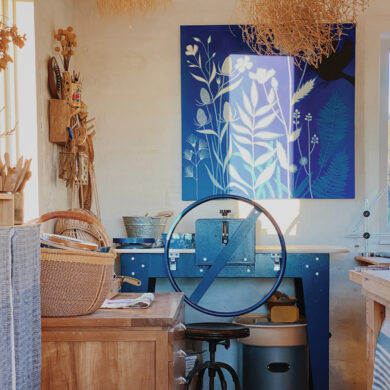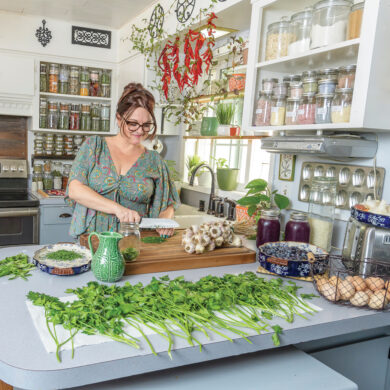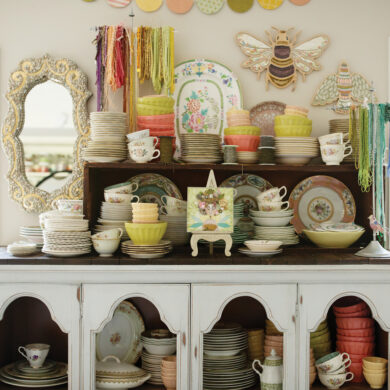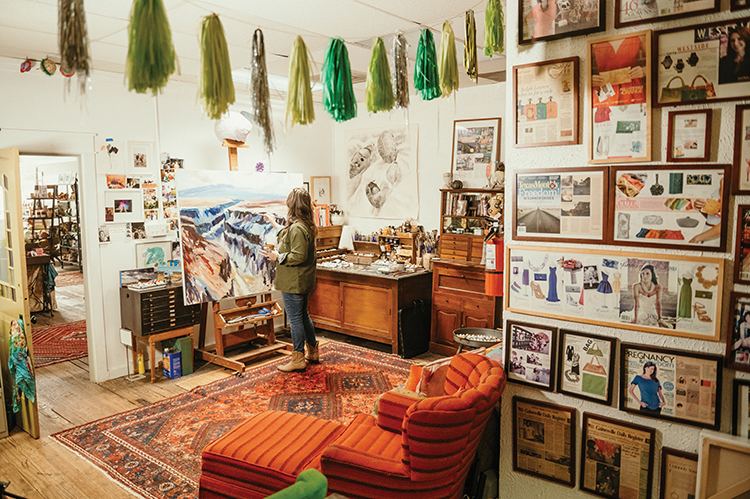
My painting studio and gallery occupy a historic building that was a dry goods store belonging to George Y. Bird, the first mayor of Gainesville, Texas. The building is covered in visible stories of its previous tenants: like the top of the arched doorway cut through the original 1800s sarsaparilla mural from when it was Bird Dry Goods; and the oil spills, automotive paint splatters and visible traffic patterns worn in the original wooden floors by my grandfather’s feet when it became his auto parts store in the 1940s.
After getting my BFA from the University of Texas, I lived in Austin, thinking I had to live in a big city to get my art career rolling, while the realities of extraordinary rent and heavy distractions were keeping me from finding my footing or focusing on paint.
I decided to move temporarily back to my quiet hometown to take a breath and regroup, and took up residence in the crusty old warehouse — with no AC, hot water or shower — that had been a shop area behind my grandfather’s business decades before. That same warehouse had been my dad’s graphic design studio in my childhood and was where he hand-lettered signs, did logo design and screen printing. It is where I started my creative journey as a kid playing with his expensive markers, paints and typography books and watching him pull the long-haired brushes covered in 1 Shot sign paint with slow grace.
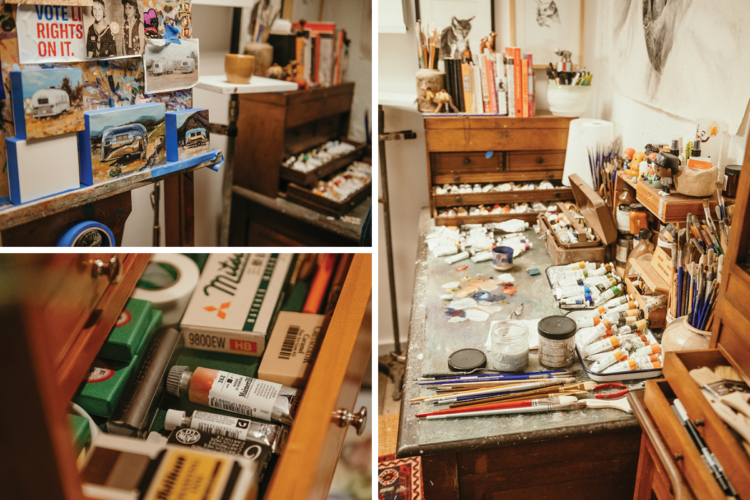
After college, pulling myself out of the noise and influences of the city and putting myself back in that familiar space, I realized almost immediately that when I gave myself room to breathe, I was able to think and had freedom to create.
Within a couple of years, in addition to the gallery shows I was doing, I began opening my modest little warehouse with a gravel-alley entrance
as my own gallery space; printing postcard invitations on my inkjet printer and mailing them to friends and townsfolk to come see my self-curated exhibitions. Word spread and strangers started showing up and wandering through my bedroom and bathroom, so I took another big breath in 2007 and decided to renovate the building next door that had been the old parts store and create a more substantial, refined and public gallery space with a painting studio in the back.
For the last 16 years, I’ve continued to add my own splatters and notches to that rich history as I’ve created my own space there. My giant worktable’s surface is a visible history of my childhood, scarred by decades of silk-screen inks, turpentine, X-Acto blades and holes from screwing in screens. Like the floors in the building, I wanted to preserve that family history and just sealed the surface instead of sanding it off.
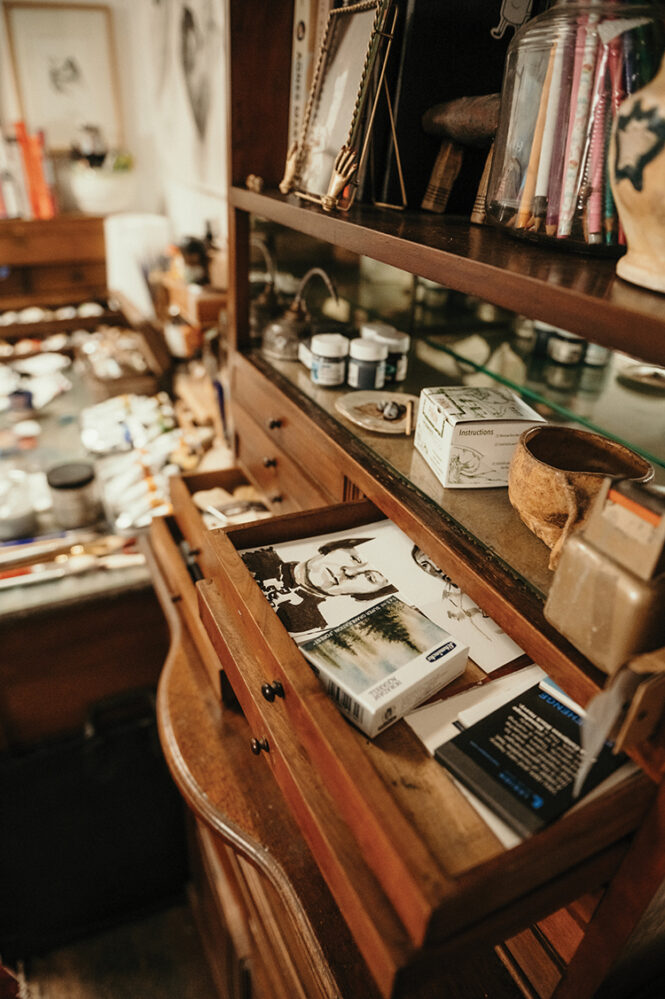
The furniture and objects around me tell stories, like the Victorian English dental cabinet my antique-dealing grandfather had sold to a client 50 years ago that she returned to me last year to house my supplies. She just walked in one day and said, “I have something you need.” Its beautiful, shallow little wooden drawers are perfect for storing my pens, colored pencils, photo sources and tubes of color. My red striped studio chair belonged to the mother of one of my pottery mentors. The kantha-covered, mid-century studio couch is one that my antique-dealing grandmother helped her best friend pick out in the 60s.
I know she and my grandfather would’ve been right at home sitting there today drinking scotch and water and watching me paint.
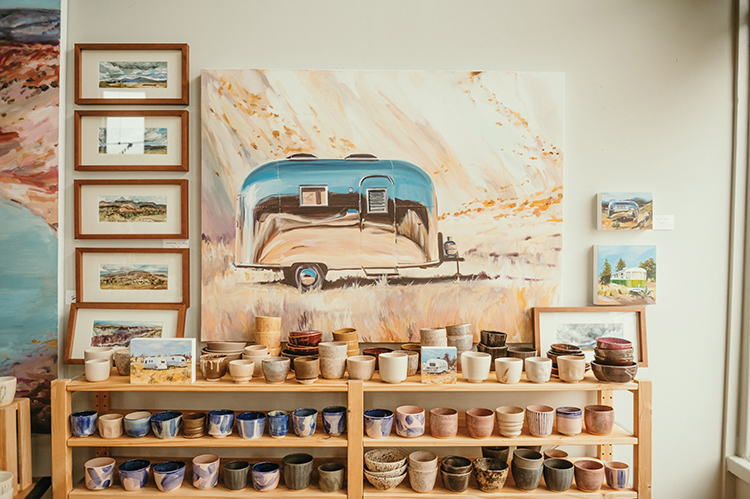
My pottery studio occupies a space at home but has a similar feel, filled with vintage hand-knotted rugs, a reupholstered chair that belonged to my husband’s grandmother, shelves loaded with art and treasures collected on our travels. There are vases created by the potter who taught me to throw in high school and stacks of pottery books gifted to me by my dad’s high school art teacher, who later became a good friend and mentor to me.
What might appear chaotic to others feels like comfort to me — my own sentimental nest. Surrounding myself with spirited objects, photos, collections and stories, I feel propped up by inspiration and history.
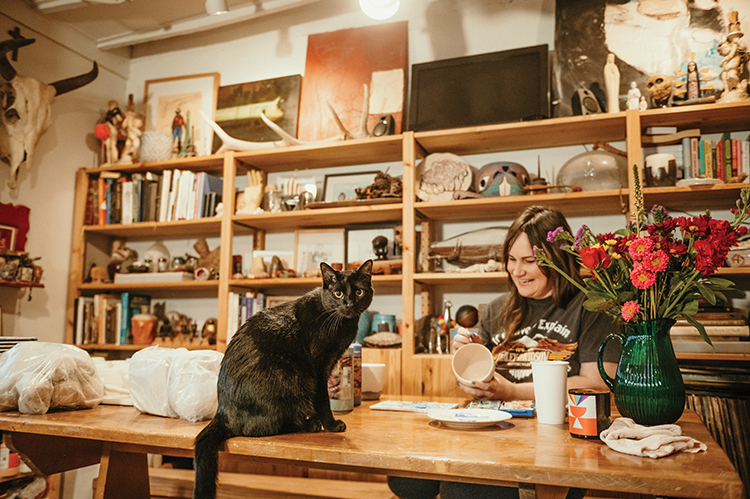
My feline studio assistant, El Guapo Mole Santo Domingo de Guzman (aka Boppy), who we adopted last year, also spends his time in the pottery studio and gives me constant reminders to take a breath, get a snack, drink some water and stretch. He enthusiastically runs to the studio when he hears the giant industrial sliding door roll open between our kitchen and the studio, launches himself onto the middle of the big wooden worktable, usually full of fragile and drying bowls, and often leaves his collaborative prints inside a piece or two. (Those pieces are in high demand at the gallery, and everyone knows him by name.)
He gets his work done, checks the state of things and usually ends up napping with his black fur or whiskers coated in white clay in the middle of the workspace.
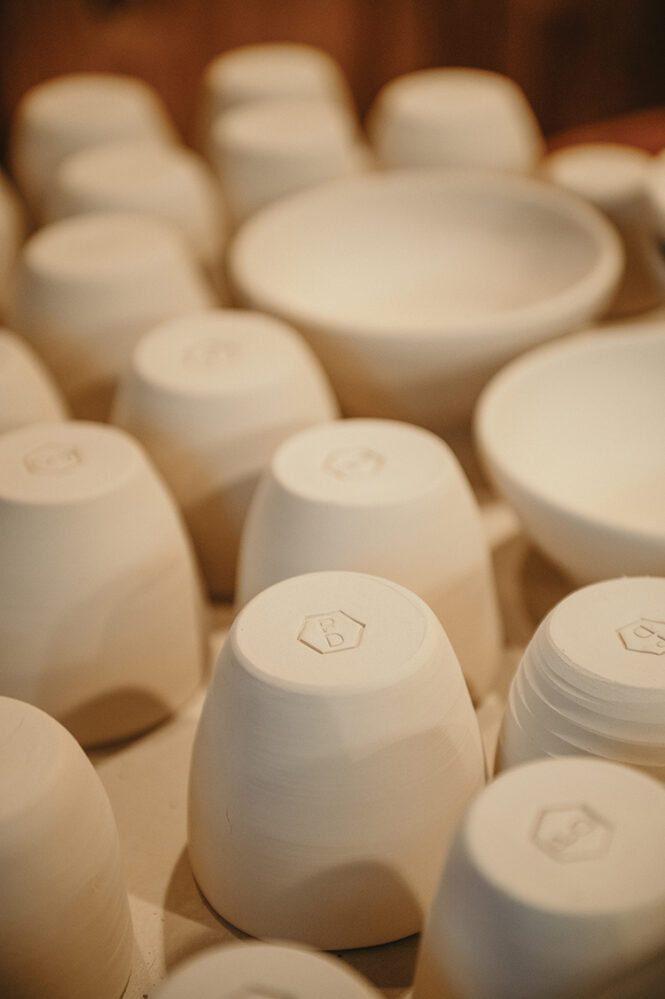
Over the last 20 years, as my business has grown and I’ve grown older, I’ve searched for more balance. I’m fortunate to be able to sell work directly to my collectors and often build close, personal relationships with them. They become like family, whereas selling through other galleries feels less personal and more high stress for an introvert like me.
Giant impersonal openings aren’t something I’ve ever been interested in. The business hat is always much more challenging for me to wear than the creative hat. The pandemic nudged us all toward self-reflection and reevaluation. As a result, my studio practice has shifted. Previously, I was working in the gallery and its painting studio all week, burning my candle at both ends trying to squeeze in time at the easel, terrified that if I wasn’t available to everyone 24/7 my business would crumble — or I would be forgotten. Lockdown shifted my attention to really focused studio time and opening the gallery only on weekends. I began working more at the home studio, happily isolated, uninterrupted by visitors, able to stretch my workdays longer because of schedule flexibility.
Taking a step back from gallery retail hours meant that I could spend more intense time working long days on huge canvases, or in the pottery studio working on more elaborate projects without worrying about drying schedules. I started creating exponentially more work and feeling a lot more creatively fulfilled because the momentum was continually building rather than getting broken by interruptions. To my very pleasant surprise, I began selling more work, despite being open less. The freedom I had when I started my business in the crusty warehouse returned.
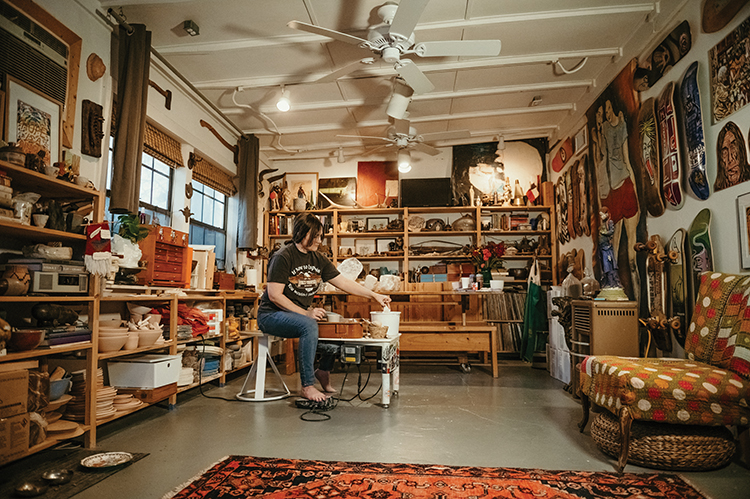
I’m a big believer in creative momentum. In Austin, my creative life had been stagnating and sputtering because I couldn’t give it enough time. I didn’t have a daily practice, as I do now. Because the ball is now consistently rolling, new work and opportunities are constantly presenting themselves. I always have art critic Jerry Saltz on my shoulder whispering, “Get to work, you big baby.” There’s a constant drive to pick up a drawing tool or brush. It allows me to move fluidly between the painting, drawing and pottery, and the themes and ideas crawling around overlap those mediums.
That momentum has always been more critical to my personal practice than the actual physical space. Some of my most productive times are when I pack my bag full of watercolor palettes, stacks of paper and my noise-canceling headphones — full of tunes and audiobooks — and hit the road to paint. I spend full days, sunup to past sundown, racing the sun with my brush, capturing the composition and color of the earth before the sun shifts and changes every detail.
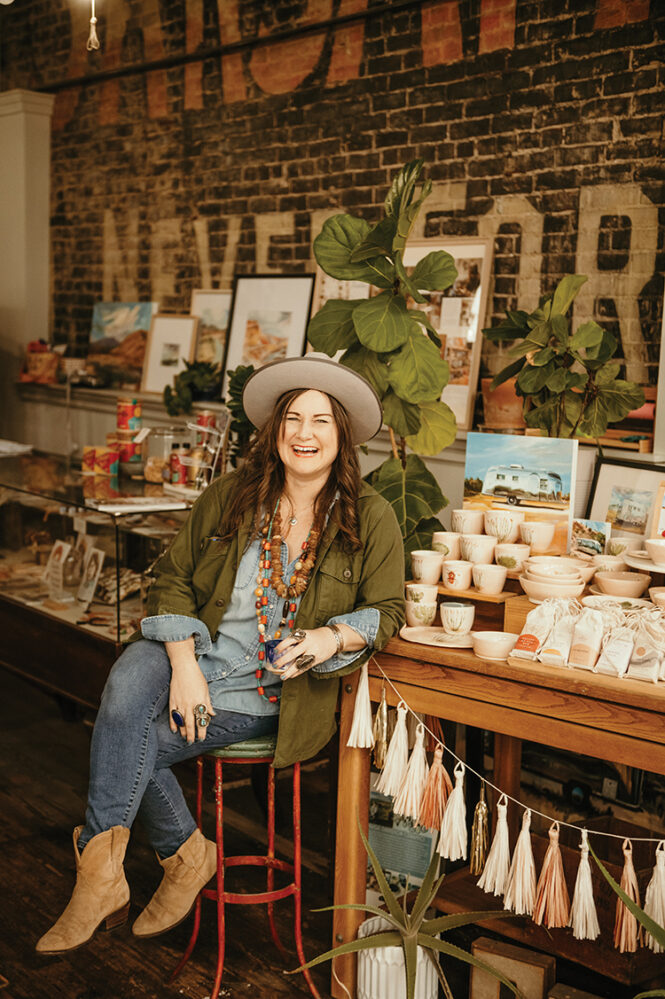
My life’s goal, since a preschooler in my dad’s studio, was to be an artist. Creating something with my hands and living a creative, happy, colorful life is all I have ever wanted to do. I’m grateful and astounded every day I get to do it, whether it is on one of my formal painting road trips into the high desert where I end up sitting on a rock on a hiking trail with my paints, or throwing pots in the pottery studio with El Guapo, or studying light and shadow and temperature shifts on earthworms or beetles and heaps of earth and finding the magic there.
So much of my work, such as the paintings of vintage Airstream trailers, is about reflection — both literal and figurative. I’m grateful to have settled into a space that allows me to reflect on my personal history on a daily basis.

